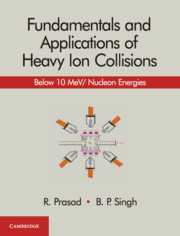3 - Experimental Details and Formulations
Published online by Cambridge University Press: 20 October 2018
Summary
Introduction
As has been mentioned in the introductory chapter, the initial interaction between a projectile and the target may result in the formation of an excited composite system from which nucleons or clusters may be emitted before a completely fused compound nucleus is formed. Such a process is generally referred to as the pre-compound emission (in case of nucleonic emissions) or incomplete fusion (when cluster emission takes place). Incomplete fusion/PE-emissions become more important as the incident beam energy increases; in fact, they become dominant at energies above 15 MeV/n. The measurement and analysis of excitation functions for the population of reaction residues may provide valuable information regarding the dynamics of incomplete fusion reactions. The resulting product nucleus of incomplete fusion has a momentum that is severely reduced as compared to the residues of complete fusion events. The measurement and analysis of momentum transfer via recoil range distribution is one of the most direct and irrefutable method of identifying incomplete fusion events. Details of the measurement of linear recoil range distributions (RRD) will be discussed later in the chapter. In incomplete fusion (ICF), residues recoil before the establishment of a thermodynamic equilibrium, and therefore, carry information about the initial system parameters that is reflected in the angular distribution of residues. Details of the measurement and analysis of residue angular distributions will also be presented in this chapter. In a typical experiment, residues are formed via complete fusion as well as via incomplete fusion processes. The product residues of complete fusion carry larger excitation energy and higher spin angular momentum when compared to the residues populated via incomplete fusion. This difference in their properties affects the spin distributions of their excited levels. In order to further investigate such systems and study the role of input angular momenta in ICF reactions, in-beam experiments involving particle–gamma coincidence method have been performed. Details of these experiments will be presented in the following sections. In recent years, incomplete fusion reactions have been observed even at energies as low as 3 – 7 MeV/n, where only complete fusion is likely to dominate. The present monograph deals with the description of such reactions in the low energy regime.
Information
- Type
- Chapter
- Information
- Fundamentals and Applications of Heavy Ion CollisionsBelow 10 MeV/ Nucleon Energies, pp. 88 - 130Publisher: Cambridge University PressPrint publication year: 2018
